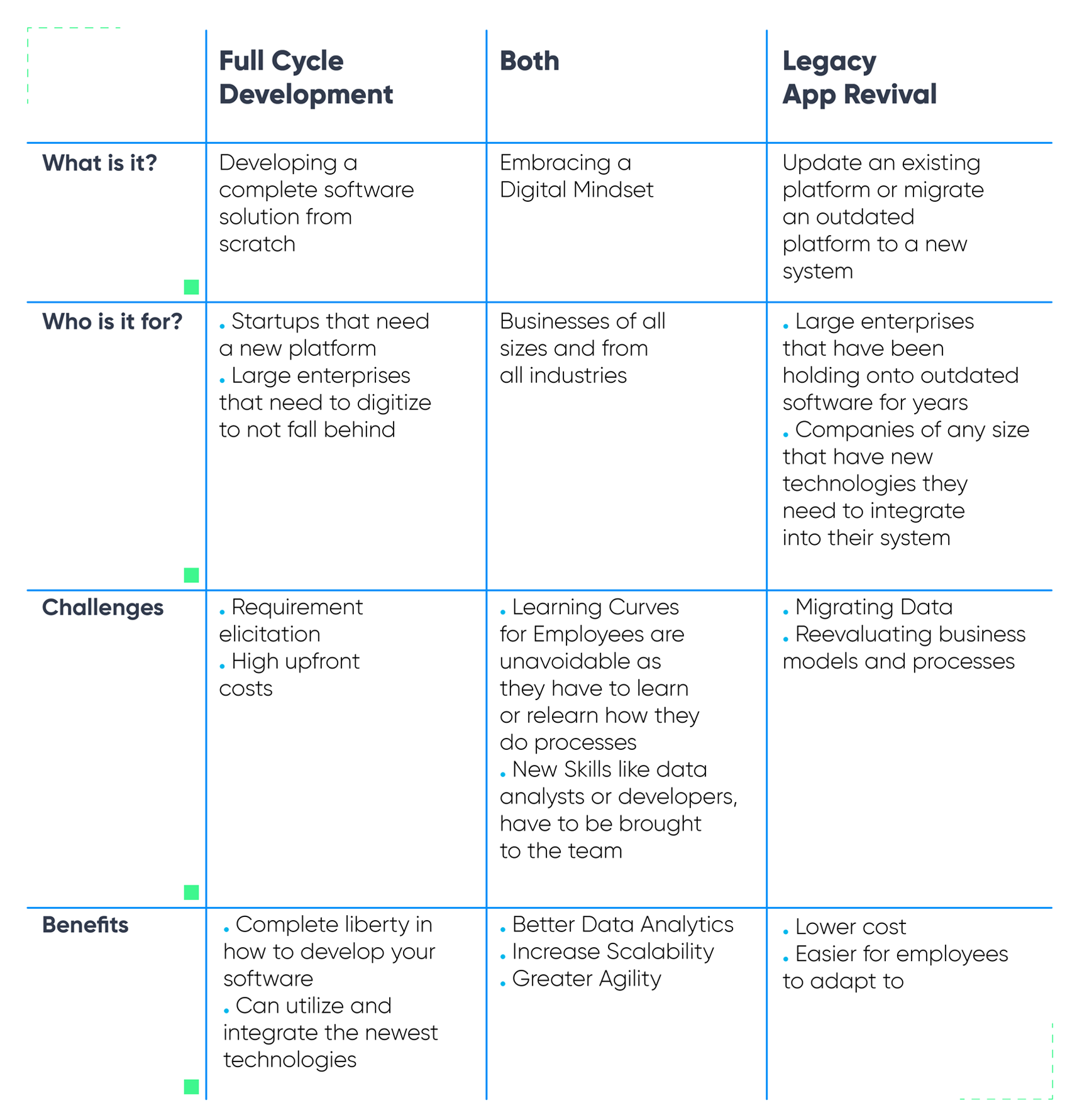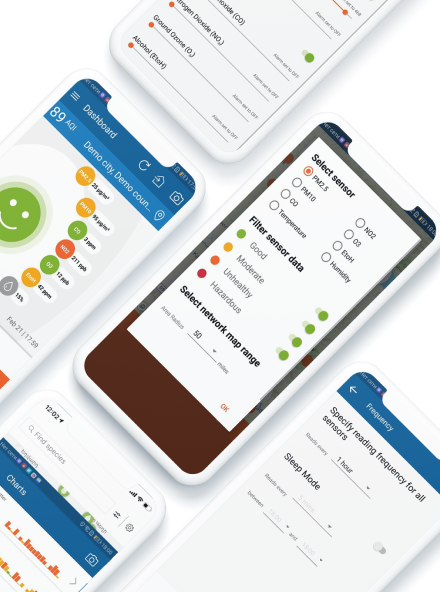
Does My Enterprise Need Digital Transformation?
29 Jan 2024

An Ever Digitizing World
In an ever digitizing world, the path to sustainable success for enterprises is undergoing a rapid shift to technological supremacy. The era of traditional business models and processes is making way for a new digital front.
In fact, studies show that the vast majority of businesses that underwent digital transformation saw significant economic gains (International Review of Economics & Finance).
Where does your business stand?
This blog will cover the new shift in the market and answer the burning question: “Does my enterprise or business need digital transformation?”
We will cover the main types of digital transformation: Full Cycle Development and Legacy App Revival, their benefits, challenges, and what to expect during the process.
To give you an idea of what successful digital transformations look like, we'll showcase real-world examples of digital transformation projects of all types, including instances of successful project recovery.
By the end of this blog, you'll be equipped to make informed decisions tailored to your enterprise's specific needs. Let’s dive into the rising wave of digitization.
What is Digital Transformation for Enterprises?
Simply put, digital transformation is adopting new software and processes that automate workflow, increase scalability, and make the company more agile. Many industry leaders are adopting the digital mindset of restructuring their company to focus more on the technology behind their product to meet their goals.
.png?sfvrsn=ac6e454_4)
The main types of digital transformation can be divided into two categories: Full Cycle Development, for those that need completely new software or digitize one aspect of their business, and Legacy App Revival, for those who need to update their existing system.
Stages of the Full Cycle Development Process
Whether you are starting at square one and need new software from scratch or need to digitize an existing one, you need full cycle development services. Full Cycle Development happens in stages with you and the software development team getting together to plan, develop, and deploy a solution.
Everything begins at the whiteboard. A discovery and business analysis session is needed to define the needs of the market, your business, and users. As needs become clearer, a variety of solutions need to be weighed out to see which type of software solution is the best fit for your business.
After defining the architecture of your platform and software, a roadmap is drawn up. Developers begin transforming your ideas into code, and after cycles of refinement, your new software begins to take shape. Through rigorous testing and quality assurance, your software will soon be ready for deployment.
.png?sfvrsn=d91f91b2_4)
Legacy App Revival
If your business or enterprise has been using the same software for a while, it may be time for a Legacy App Revival. It sounds as simple as migrating your data and processes to new software, but still entails lots of complex planning and development.
After assessing your current software and processes, the development and consulting team can begin looking at suitable software to migrate to. A new user interface and experience has to be developed along with defining what new processes will be available in the new platform.
During Legacy App revivals, it is important to try to centralize all processes into one software, making it more efficient, secure, and easily accessible.
While migrating to new software has become more streamlined, it still requires some downtime in workflow to work out bugs, get staff on track with new procedures, and can have significant upfront costs. However, the longer you wait to migrate or embrace digital transformation, the more data and processes you will have to account for.
Making small improvements over time is fine when there is already a solid foundation. But trying to incorporate new technologies or scale on old software has severe limitations that can cap your growth and force you to adapt to digital transformation either way.

Benefits of Digital Transformation
Whether opting for a Full Cycle Development approach or breathing new life into existing systems through Legacy App Revival, the agility gained allows you to quickly adapt to emerging technologies, market trends, and customer expectations. The ability to pivot ensures that your business remains on top with a reputation of always meeting market demands.
With the adoption of cloud technologies, enterprises gain more than just storage. They open up a secure world of easy access and collaboration. Whether you're building from the ground up or revitalizing legacy applications, the cloud provides a scalable platform for your digital ecosystem without any technical bottlenecks. You can expect to save big with a centralized server that always has room to expand.
The scalability unlocked by digital transformations enables enterprises to expand based on demand. You will be elastic enough to scale up or down depending on market conditions in an efficient manner without having to rethink your structure.
In-depth analytics is key in strategic decision-making, yet only 30% of business owners trust their own company data. The data-rich environment brought by digital transformation opens doors to a deeper understanding of customer behavior, market trends, and operational efficiency. You will be able to make more informed decisions, optimize processes, and stay ahead of the competition.
Standards for user experiences are always on the rise. According to eConsulting, more than 70% of users will no longer use a site if they have poor user experience. User Interface and Experience takes center stage in the digital transformation narrative. Customers will love your brand more when they have pleasant experience with your software that is intuitive, quick, and accessible.
A more user-friendly interface not only enhances customer satisfaction but also reduces the learning curve for employees navigating new technologies.
Challenges of Digital Enterprise Transformation
While digital transformations are well structured and have many aspects standardized, there are still similar challenges that all projects have to face. While each case has its own unique issues, we are going to cover common hurdles to expect during your enterprise's digital transformation.
Training employees on a new platform can be difficult, time consuming, and even resource intensive if precautions are not taken. It is vital to have a strong UI/UX team to design user-friendly experience for all potential users. The benefit of digital transformation is that it has a large potential to be intuitive to use, but it is still necessary for your development partner to make it user friendly.
The upfront cost of digital transformation can seem high, especially compared to just making small changes with an in-house team. An entire new platform would have to be developed while the in-house team would still have their usual load. By outsourcing to a reputable digital transformation agency, it can be cheaper, more efficient, and yield a more favorable outcome. Why? An agency that specializes in digital transformation can offer better solutions and insights in the best platform to choose, develop better than your busy in-house team, and save in upfront costs.
Shifting to a new digital world usually entails a new business model. Many of the standard purchases, services, and licensing models have now shifted to a world of freemium, cheap subscriptions, and ad-support. It is important to gauge which business model will help your business maintain profits, expand its user base, and keep users engaged after digital transformation.
Why to Outsource Your Digital Transformation?
In-house teams are already burdened with keeping things running smoothly, it is unrealistic to expect them to handle their daily tasks and come up with a completely new solution. In a Deloitte Global Outsourcing Survey, when asked about the main benefits of outsourcing, around 65% of the respondents said that it helped them focus on their core business functions. A specialized outsourcing team with a track record, already has all the base knowledge needed to start planning digital enterprise transformation solutions. The outsourcing team will know what is viable, effective, and within your budget.
.png?sfvrsn=51e7424a_4)
While digital transformation may take some time, hiring in-house requires significant financial commitments, training, and management. It is much easier to outsource all of that and focus on working with an outsourcing team to develop a product that meets all of your requirements. It is cheaper to pay the outsourcing company to develop the solution then when major bugs and updates are done, it can be handed back over to your in-house team for light maintenance.
Read more about what to expect when outsourcing software development here.
What Does Digital Transformation Look Like for Different Businesses?
Businesses and enterprises of all sizes and industries undergo digital transformation to elevate their game. Making a decision of which aspects of your business to digitize and who to partner with require research and internal discussions.
The cases we have below detail some of the processes different businesses have gone through to successfully digitize their processes.
Integrated Software for FinTech Businesses of All Sizes
One would think that finance would be at the forefront of the digital frontier but many financial enterprises are still stuck with older technology and workflows. A financial institution underwent digital transformation, updating their legacy software to new software that integrated all processes into one platform for a more efficient workflow, a centralization of financial data for more in depth analysis, and becoming more user-friendly to appeal to more digital oriented users.
Many aspects of Commodity Trading are still living in the previous decade. Larger enterprises that are slow to update their software risk being overtaken by up and coming digitized platforms that allow communication, payment, and tracking all in one place. The new generation of traders wants to be able to securely communicate from their phone, just like how they do every other activity.
A commodity trading veteran decided to bring the industry to the digital era with a new platform but their original software developer was not meeting their expectations. They got a tech consultation for a second opinion and decided that it was better to hire another software developer to rescue their project.
After the onboarding process, the new software developer agency was able to communicate more realistic goals and set up a proper roadmap.
Read more about this software recovery case here.
Legacy Software Revival for an Educational Enterprise
A startup that provided abstract illustrations for research papers needed to be able to scale up to meet rising demand. They needed to upgrade their software, processes, and implement new technology. After a consultation meeting, a plan was drawn up to bring their platform to the next level. Over the next six months, the development process went through two phrases to update their CRM processes and integrate AI to create illustrations faster.
Through these upgrades, they were able to scale their business with a new CRM system and work more efficiently with AI assistance.
Read more about this startup's success here.
No matter your industry, the sooner you adapt to digital transformation, the sooner you will be able to scale and keep up with the competition. Technology is advancing and the way people interact with the world is digitizing. It isn’t enough to add more digital features to an outdated system. An entire digital transformation is needed to make your workflow more efficient, appeal to a new generation of users, and increase the scale of operations.
See how you can start your digital transformation here.
More helpful resources:
- Guide for Digital Transformation Professional Services
- What's Driving App Modernization?
- 7 Strategies for Modernizing Your Business Apps
- VOLO's Approach to Legacy Transformation
- Updating Your Legacy Software: Everything You Need to Know
- Do Legacy Systems Block Your Business Growth?



